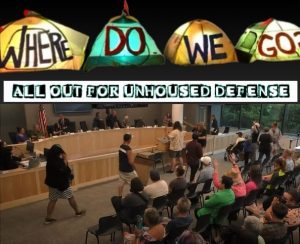Carry It Forward’s tiny homes provide shelter, workforce training, and jobs
4 min read
Gabe Casteel and Alicia Ginsburg at Carry It Forward are building high-quality tiny homes, providing workforce training, jobs, and addressing Eugene's homelessness crisis.
A Eugene non-profit can build high-quality tiny homes for the same price as a Pallet Shelter. Unlike a Pallet Shelter, Carry It Forward will also provide workforce training, and create jobs here in town.
Gabe Casteel: [00:00:14] My name is Gabe Casteel, I’m the builder for Carry It Forward, Eugene. This is my project, me and Alicia (Ginsburg), my partner designer.
Alicia Ginsburg: [00:00:22] I worked with Square One Villages for a number of years and met Gabe, who’s the builder, and we found that people had immediate need for housing. And this was an idea that Gabe has had for a long time.
Gabe Casteel: [00:00:34] So this is the prototype. This is nine feet by five feet. It’s an insulated, tiny homeless shelter for somebody to live in. I think it’s going to work great. Everything needs to have an extra purpose in a tiny house today. It’s got two lights, two receptacles, cute little door. You can stay warm in these. So they’re also going to all have their own charms. They’re all going to be different. None of them are going to be the same, that could be customized to match all kinds of stuff. So we actually just got a question about that from a church of, the way they want it to be, potentially build some, but wanted them to match their church, which is incredibly easy to do.
Thank you for supporting
local citizen journalism
Alicia Ginsburg: [00:01:14] I have a background in design. So figuring out how to translate this “napkin idea” and need into the built environment is something I always enjoy. Doing so then putting it on the computer and getting it to scale.
Heather Sielicki: [00:01:28] What are the benefits of this house over the pallet shelters?
Gabe Casteel: [00:01:32] Number one, these are built to last. So they’re going to last a long time. They’re actually the exact same cost as a Pallet Shelter, but these are built here in town and I want them, they’re designed to be built in the communities that they serve and they’ll last as long as a house lasts.
John Q: [00:01:48] Gabe figures each house will cost about two thousand for materials and three thousand for labor.
Gabe Casteel: [00:01:54] They’re built like with construction methods that we use for building houses. With that $5,000 investment, you’re going to have a shelter that lasts as long as a house would last, if you take care of it the same way as you take care of a house.
Heather Sielicki: [00:02:08] And can you tell me about any kind of training or vocational programs that you plan on creating with this?
Gabe Casteel: [00:02:13] Yeah. With Carry It Forward, we’re trying to get as many people as we can there that are interested in building. I’ve been building for 25 years. I love to teach building, so anyone coming out of their program that wants to a job teaching or wants to learn or wants a job building and wants to learn how to build we’re taking those people and putting them to work here on this project, which is cool.
Alicia Ginsburg: [00:02:33] I think that’s really important is training people who want to be trained . So it’s not only volunteer driven, but contributing on that more economic side of getting people who need jobs, and skills, not just to build these homes, but a lot of these skills would be transferable for a great housing need in the area.
Heather Sielicki: [00:02:48] Could these fit inside two parking spaces?
Gabe Casteel: [00:02:51] About one to a parking space, I think. Cause they’re about the size of a small car but yeah. We have plans to build a ADA or wheelchair accessible one. So that’s a that’s in the works already.
Alicia Ginsburg: [00:03:05] Thinking through how they can be affordably off-grid is a good next step and just thinking how they’re going to be used and where, what types of communities they’ll end up serving. So if you do need a bathroom structure or how they can be either providing need short term and then the realities of the potential that they might end up being longer-term it might not just be emergency housing. So how can they be comfortable and long-lasting.
John Q: [00:03:33] You can learn more about Gabe and Alicia’s TRAC house by visiting CarryItForward.net or sending email to info@CarryItForward.net.




